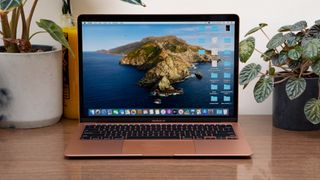This dangerous Mac malware was 'approved' by Apple: What to do [updated]
This unsafe Mac malware was 'approved' by Apple: What to do [updated]

Updated with annotate from Apple.
A well-known researcher says Apple has "notarized" a notorious piece of Mac malware, letting it sail correct past Apple tree's built-in defenses.
Apple's software notarization is an automated screening process meant to detect malware. Anything suspicious gets rejected. Everything else can exist installed on Macs running macOS 10.15 Catalina or 11.0 Big Sur, and the congenital-in Gatekeeper program will allow it run.
- The all-time Mac antivirus software to go along that Apple polished
- iPad 2020 just leaked — and it looks a lot like iPad Pro
- Plus: iPhone 12 leak reveals prices for all 4 models
But, said Mac-security researcher Patrick Wardle in a web log mail service yesterday (Aug. 30), the well-known Shlayer adware Trojan has at present evolved to include an Apple notarization postage stamp. This ways a modern Mac tin install it, and worse, lets Mac users know that Apple has inspected it and canonical it.
"In Apple'south own words, notarization was supposed to 'give users more confidence that [software] ... has been checked by Apple tree for malicious components,'" Wardle wrote.
"Unfortunately, a system that promises trust all the same fails to evangelize may ultimately put users at more hazard," he added. "If Mac users purchase into Apple's claims, they are likely to fully trust any and all notarized software."
To protect yourself from Shlayer and other forms of Mac malware (there's more of it than you might think), download and run 1 of the best Mac antivirus programs. Tom's Guide has reached out to Apple for comment, and we will update this story when nosotros receive a reply.
False Adobe Flash update
Wardle was tipped off to this development Friday (Aug. 28) past fellow researcher Peter Dantini, who noticed that a Shlayer variant served upwardly by a fake Mac developer site was given the green light past Gatekeeper when Dantini tried to install it on his own Mac.
Shlayer pretends to be an Adobe Flash update, but if yous install information technology, it pops up a tons of ads, changes your spider web browser's search engine and downloads more programs. It's the most mutual serious threat that Mac users currently face -- Kaspersky estimates that one out of every 10 Macs worldwide encountered Shlayer in 2019.
Normally, if you endeavour to install an un-notarized application in Catalina, Gatekeeper volition pop up a window stating that the app "cannot be opened because the developer cannot be verified."
Your merely options presented are to cancel the installation or move the installer file to the Trash. (There are ways around Gatekeeper, as another variant of Shlayer had already constitute .)
Why the attackers are winning
That didn't happen with this version of Shlayer. Dantini dug into the code and found that it had been accepted by Apple's notarization process at least twice.
"What does this hateful?" Wardle wrote. "These malicious payloads were submitted to Apple, prior to distribution. Apple scanned and apparently detecting no malice, (inadvertently) notarized them.
"Now notarized, these malicious payloads are allowed to run ... even on macOS Big Sur. Once again, due to their notarization status, users will (quite likely), fully trust these malicious samples."
On Fri, Wardle reported the notarized malware to Apple, which quickly revoked the developers' certificates, and Gatekeeper no longer allowed their installation.
Merely on Sunday, Wardle saw that the campaign was still running -- with a new developer ID and new Apple tree stamp of approval.
"Clearly, in the never ending cat & mouse game between the attackers and Apple," Wardle concluded, "the attackers are currently (still) winning. 😢"
This looks bad
How did the bad guys exercise this? It's not really clear, but they seem to take gamed Apple tree'southward automated notarization organization to bypass whatsoever checks exist.
"Nobody really understands exactly how notarization works, and Apple tree is not inclined to share details," wrote Malwarebytes security expert Thomas Reed in a blog post today (Aug. 31).
"I've personally notarized software quite a few times at this point, and it normally takes less than a couple minutes betwixt submission and receipt of the e-mail confirming success of notarization," he added.
"That means at that place'south definitely no human intervention involved in the process, as there is with App Shop reviews. Any information technology is, it'due south solely automatic."
Reed took a look at old Shlayer code and the new Shlayer code that Apple had notarized, and couldn't find much deviation betwixt the two.
"This leaves us facing two distinct possibilities, neither of which is particularly highly-seasoned," he wrote.
"Either Apple tree was able to detect Shlayer as part of the notarization process, but breaking that detection was trivial, or Apple had cipher in the notarization process to detect Shlayer, which has been effectually for a couple years at this point."
Apple tree responded to our query with this statement, in full:
"Malicious software constantly changes, and Apple tree'southward notarization system helps united states keep malware off the Mac and allow us to reply quickly when it'southward discovered. Upon learning of this adware, we revoked the identified variant, disabled the developer account, and revoked the associated certificates. We give thanks the researchers for their assistance in keeping our users safe."
Also, we've learned that the Apple developer ID being used by the malware yesterday has now been revoked.
Source: https://www.tomsguide.com/news/apple-approved-mac-malware
Posted by: shieldsdinen1964.blogspot.com


0 Response to "This dangerous Mac malware was 'approved' by Apple: What to do [updated]"
Post a Comment